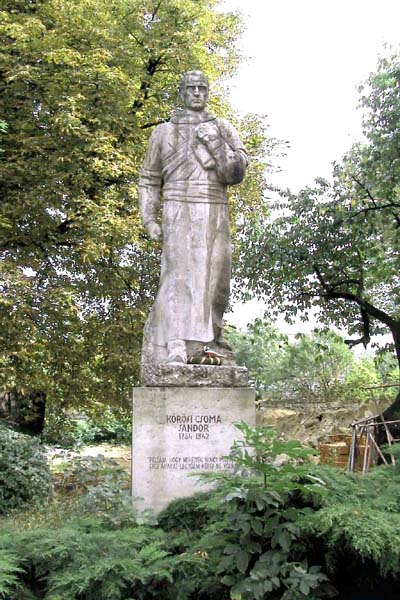Alexander Csoma Körösi ( Hungarian Geographical Museum )

Kőrösi Csoma Sándor magyar nyelvtudós ( Kőrös, Erdély, 1784 - Darjeeling, 1842).
Az ázsiai magyarok felkutatásának szándékával indult útnak 1819-ben. Törökországon, Perzsián, Afganisztánon és Indián át Nyugat-Tibetig jutott. 1823-1824-ben a zanglai lámakolostorban ( Tibet ) tibeti nyelvészettel foglalkozott, majd elkészítette az első tibeti nyelvtant és a tibeti-angol szótárt, 1837-től Calcuttában a Bengáli Ázsiai Társaság könyvtárának tibeti kéziratait rendszerezte. 1842-ben eredeti tervének megvalósítására Tibet felé indult, de útközben maláriában megbetegedett és meghalt.
Főbb művei: Kísérleti tibeti-angol szótár 1834, A tibeti nyelv angol nyelvtana 1834, Dolgozatai 1885, Buddha élete és tanításai 1957.
Alexander Csoma Körösi Hungarian linguist was born in the year
1784 in the town of Körös in Erdély (Transylvania). He completed his secondary
education in the Collegium of Nagyenyed. From here he went with a British
funded scholarship to the University of Göttingen, where he completed his
preparation for his chosen field between the years of 1815 and 1818. This
preparation already began in his school years in Nagyenyed, where he excelled
not only in his scholarly preparations but also in self imposed discipline
and fitness program. Even as a young man he knew that his life’s goal is
to find the relatives of the Hungarians east of the Carpathian valley.
He did show an intense interest in languages, the eastern languages in
particular. He was teaching himself Turkish during his stay in Nagyenyed.
In Göttingen he studied history and Eastern languages from Johann Gottfried
Eichhorn, a renown scholar of his day. He learned here the Arabic, Persian
and Turkish languages. He studied English from professor Fiorillo, and
anthropology from Blumenbach. (Wurzbach Biographical Lexicon Vol.III..)
After the completion of his studies his road led from Erdély to Darjiling
in quest of his life’s goal. He spent years in Tibetan monasteries and
communities, like Zangla, Phuktal, Kunavar where he studied not only the
ancient Tibetan documents but also the language, religion and culture of
the surrounding countries also. He did this relying only on his own meager
resources in order to maintain his scholarly independence and integrity.
He added to the already vast knowledge several other languages. He
spoke seventeen languages plus his native Hungarian. These were the Latin,
Greek, Turkish, Arabic, Hebrew, Sanskrit, Pasthu, Persian, Tibetan, Hindustani,
Marathi, Bengali languages, German, English, French, Italian, and his biographer
mentioned a Slavic language, without specifying which of the Slavic languages
this was.
His most significant works are:
Tibetan and English Dictionary, written between 1827 and 1830, published
in 1834
Grammar of the Tibetan Language in English
Tibetan wordlist concerning the vocabulary and the entire system of
Tibetan Buddhism.
A study concerning the affiliations between the Hungarian and the Sanskrit—
Hindi — Maráthi, etc. languages. These remained unpublished and can be
found only as an appendix in his biography written by Duka.
His studies concerning the Buddhist literature appeared regularly in
the official journal of the Asiatic Society, the Asiatic Research. At this
time he researched the onehundred volumes of the “Kandjur."
He translated the Protestant liturgy, the psalms and a prayerbook for
the missionaries into the Tibetan language. These were still in use in
the Moravian mission in the 1950’s.
He drew parallels between the theories of Buddhism and Christianity
and found the similarities important and worthy for further study.
He catalogued for the Asiatic Society Hodgson’s collection about Nepal
that contained the Sanskrit material of the Northern Buddhism. He corresponded
a lot with Hodgson, who sent the material of these correspondences to the
Hungarian Academy of Sciences.
He did teach Tibetan to an interested individual out of love of his
subject and later donated thirty Tibetan books to this student. These too
were eventually donated to the Hungarian Academy of Sciences.
He established the groundwork for transliterating the Tibetan script
into Latin letters.
He was vastly ahead of his time’s scholars in recognizing the presence
of Huns in China over two-thousand years ago.
His work concerning the Tibetan dictionary, grammar and script he was
the first to open the road to Tibetan literature and made the study of
northern Buddhism possible.
He found the correspondences in Sanskrit and Hungarian significant
and urged further study.
He wrote his name in the following manner: Körösi Csoma Sándor in his
native Hungary; he used the form Alexander Csoma de Körös in his English
correspondences and publications, such as the front page of his Tibetan
dictionary; the name Alexander Csoma de Kőrös appears on the front page
of his Tibetan Grammar. In Persian texts he used the name Molla Eszkander
Csoma ez Mulk-i-Rúm.
From 1833 he was corresponding member of the Hungarian Scientific Society.
He was named honorary member of the Asiatic Society on February 6,1834.
This was the world’s first Oriental Institute.
His wordly possessions at the time of his death consisted of the following
items: four trunks full of books, a suit in which he was laid to rest,
a few sheets and one cooking utensil.
His biographer, Duka has seen the trunks in 1854 and prepared a list
of their contents. Among these he mentions three Tibetan manuscripts consisting
of 60, 30 and 26 pages. These he called “examples of letters in the Tibetan
language.” When the Asiatic Society moved to other quarters these trunks
became lost.
His biographers are the following:
Theodore Duka M.D. Life and Works of Alexander Csoma de Körös, Trübner’s
Oriental Series, London 1885
The Hungarian Geographic Society On top of the world — Following Sándor
Csoma Körösi to western Tibet, Budapest 1930
Sir William Wilson Hunter A Pilgrim Scholar, published in the The Pioneer
Mail in installments in 1885. This was later translated by Duka into Hungarian
and published in the Budapesti Szemle. The Royal Asiatic Society published
in its official publication in 1825 Csoma’s report concerning his works.
Debreczy Körösi Csoma Sándor csodálatos élete (The Miraculous Life
of Sándor Csoma Körös), Sepsiszentgyörgy, 1937
Ervin Baktai Körösi Csoma Sándor, Budapest, 1963
The bulk of Körösi’s work is being cared for by the British Museum
in London.